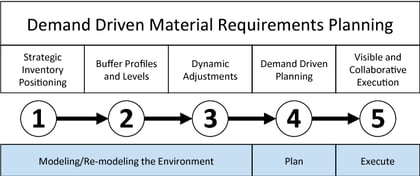
Since I joined the Solventure team, I have been on an exciting journey. At Solventure, we are constantly challenged to develop ourselves in the best possible way. A part of my personal development trajectory is following the Supply Chain Masterclass at the Vlerick Business School – a course that I would warmly recommend to all supply chain professionals.
In that context I am now writing a dissertation on Demand Driven Material Requirements Planning (DDMRP). There’s quite a buzz, these days, the opinions still differ about the DDMRP methodology. By doing research about DDMRP and thus also surveying a broader audience, I want to direct the conversation to a factual discussion: why should we introduce DDMRP? What are the essential aspects? How can it help companies? And what are the best practices or lessons that can been learned?
Researching DDMRP, based on real life input, should allow us to only apply DDMRP when it delivers a real value add. Maybe a DDMRP roll-out makes more sense in some specific industry sectors? Or perhaps it is only proving ROI in organizations of a certain size or with a certain type of demand (cf. make-to-stock vs. make-to-order)? Or is it the efficiency of DDMRP in proportion to the amount of variability and volatility of a specific market?
To answer all these questions, I conducted a study to get a better understanding of the current role of DDMRP in the market. Driven by these results, we took next steps within Solventure and developed a proof of concept for the DDMRP methodology. You can read more about this in our blog.
DDMRP is a planning logic conceived in 2011 by Carol Ptak and Chad Smith, both founders of the Demand Driven Institute. With the DDMRP concept they aimed to protect the flow of goods and information, combining the best of the ‘push’- and ‘pull’-worlds. This by adopting concepts from well-proven methods such as Theory of Constraints (ToC) and lean manufacturing. While MRP and DRP are advocates of the ‘long-term mainstream’ push logic, ToC and lean are bringing in the ‛pull' methods.

Strategic decoupling (1), buffer sizing (2) and dynamic adjustments (3) are 3 of the 5 key characteristics of DDMRP. After putting these planning-settings in place, DDMRP will drive the planning (4) by generating supply orders based on a “net-flow” position, actual on-hand plus the open supply minus the relevant demand. The last and essential part in executing (5) DDMRP, is the intention to be simple, straightforward and easily understandable. It is using an intuitive color coding (Red, Yellow and Green) and a prioritization system based on the relative inventory position.
We know that the Demand Driven movement is much larger than DDMRP, e.g. the Demand Driven Adaptive Enterprise, however, this a topic for another blog. More info can be found on the DDMRP website.
Watch our DDMRP webinar with Kilian Vincke and find out more about the way to DDMRP!
These Stories on Inventory Planning